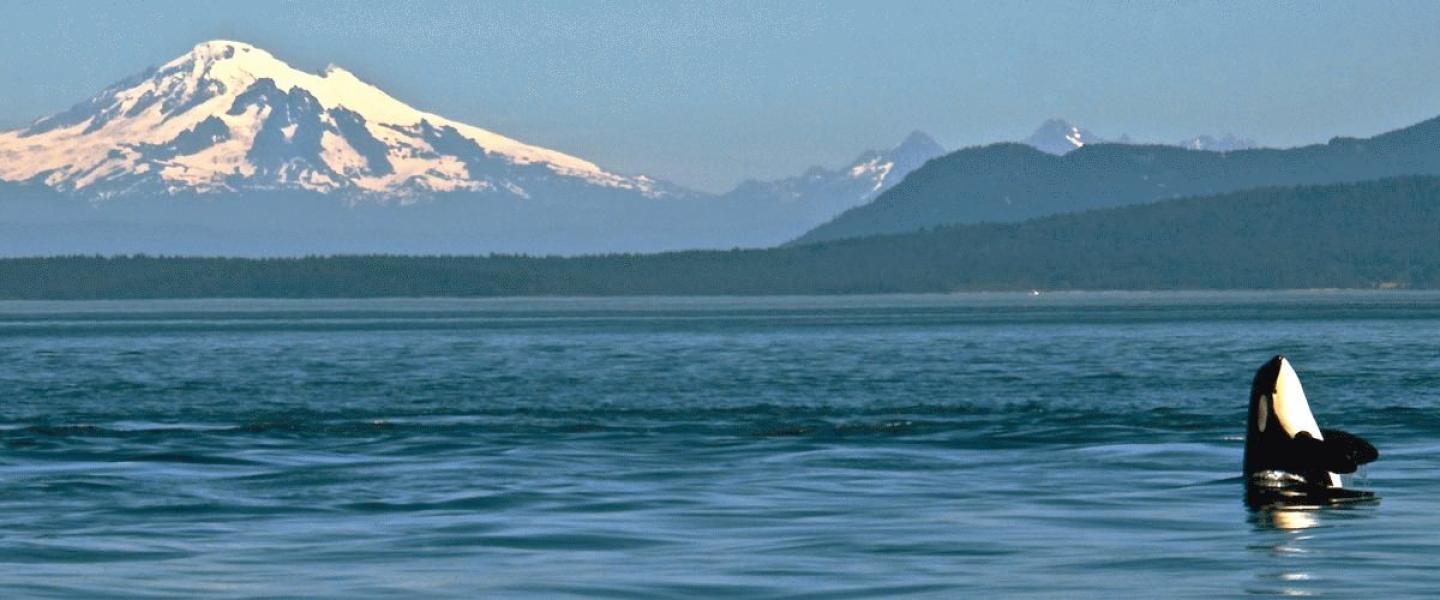
We had a last minute private charter today. I was scheduled to laminate, type and answer phones from 8am to 5pm, when in the middle of the afternoon, a man called wanting to charter the boat. His family from Denmark had been delayed an extra week in the states, not able to make it home because of the ash over Europe. The Icelandic that volcano grounded all planes. A lovely family, they enjoyed talking amongst themselves, and translating the stories and facts to their grandmother. The 10 year old grandaughter was especially sharp- reading attentively and quick to understand when I showed her the fathom markings on the chart.
As we left Friday Harbor, we headed north. Immediately after passing the University of Washington Marine Science Labs, we saw 8 Eagles resting along the shoreline in the tops of trees. There was even a pair sharing a branch, resting right next to each other. As eagles mate for life, it's easy to venture that they're a mated pair.
Soon after, we spotted 2 Harbor Porpoise calves. Tiny little things, we ALMOST didn't see them. They plunged through the water quickly, only their dorsal fins sticking out. It's been discovered by Anna Hall, scientist out of Victoria and naturalist that Harbor Porpoise in this area have a small home range, and because of this, memorize the geographical features. By extension, during the day they are visual hunters, saving echolocation clicks for the dark.
At Green Point off Speiden, we had the best view of 1,500 pound male Steller Sea Lions swimming that I've ever seen. They would come up for 3 short breaths and then dive to continue the hunt. When we first got to the scene there was a flock of gulls scavenging leftovers. That's how we first spotted the sea lion, because he came up in the middle of the flock, sending them scattering. My favorite sight of the day were the Bonaparte Gulls on the scene in their breeding plumage. Bonaparte's are tiny and look more like graceful terns than gulls.
It was truly 'an adventure on the high sea' for as we rounded Turn Point, we saw an abandoned skiff. An unusual scene, the boat still had the owner's wallet and passport onboard and unfortunately, a suicide note. It was inferred that the man used an anchor to weigh himself down. The skiff was discovered at the boundary between Canada and America by Canadian whale watching boat 'Neptune.'
The skipper and passengers on the Neptune secured the area while waiting for the Coastguard. They were the first to discover tonight's news. When a mayday call is broadcast, any boat that is nearby and able to help, is absolutely required to do so. There are times when passengers on a cruise become witness to rescue efforts, or rescuers themselves.
There are approximately 172 islands in the San Juans at high tide, but about 700 landmasses at low tide, which means that at high tide, hundreds of landmasses are possibly only a few feet below the surface of the water, which means that they aren't visible but they are a threat. Boats often run aground, and the publication '11 Most Commonly Hit Rocks and Reefs' is something that savvy boaters memorize. Responsible boaters in the San Juans use fathometers, GPS and radar. The good news is that if you run into trouble in the San Juans, help is never far away as this is a populated area. Boating is far safer than kayaking or rock climbing, but its good to have a reminder that the unexpected does happen, and you may just get more than you paid for. It truly is an outdoor adventure.
Orca Whales and Wildlife Are Our Only Business. ©
San Juan Island near Seattle: Home to the Southern Resident Killer Whales